2010–2011 Season
Mrs. Warren’s Profession
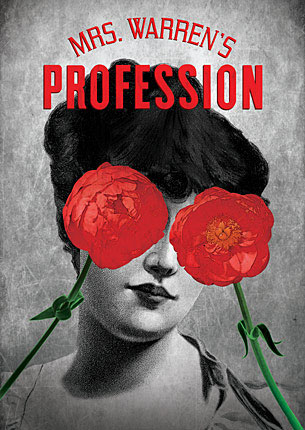 In this 1893 play George Bernard Shaw poked fun at the hypocrisy of the British class system, particularly in the way it treated women. For Mrs. Warren’s profession was prostitution, a reviled occupation from which she gained great riches and power while the so-called revered genteel occupations of waitress, laundress or what have you brought poverty and drudgery to those engaged in it. The play consists of the struggle between Mrs. Kitty Warren and her well educated—by means of her mother’s money but unbeknowest to her—daughter Vivie who is an uptight holier-than-thou sort who rejects anything not pristine pure—including both her lovers and her mother. This should be an exciting and engrosing battle but this production is hampered by Cherry Jones' (Kitty Warren) uncertain accent which is never clearly discernible and often inaudible and Sally Hawkins (Vivie) uncomfortable rigidity—which leads to more posturing than necessary. Yet both these actreses are excellent performers in other roles and they will be so again. The supporting cast varies from an excellent Edward Hibbert as Mr. Praed, a friend of Mrs. Warren, to a less than charming Adam Driver as Frank Gardner who is not sufficiently creamy or delightful as the would be lover of Vivie. Mark Harelik is a competent partner of Mrs. Warren and an adequate Reverend who is the father of the less than charming Frank among other things. Scott Pask has designed sumptous sets but the hair and wig design of Tom Watson leaves much to be desired. Doug Hughes has directed with something less than his usual brilliance.
In this 1893 play George Bernard Shaw poked fun at the hypocrisy of the British class system, particularly in the way it treated women. For Mrs. Warren’s profession was prostitution, a reviled occupation from which she gained great riches and power while the so-called revered genteel occupations of waitress, laundress or what have you brought poverty and drudgery to those engaged in it. The play consists of the struggle between Mrs. Kitty Warren and her well educated—by means of her mother’s money but unbeknowest to her—daughter Vivie who is an uptight holier-than-thou sort who rejects anything not pristine pure—including both her lovers and her mother. This should be an exciting and engrosing battle but this production is hampered by Cherry Jones' (Kitty Warren) uncertain accent which is never clearly discernible and often inaudible and Sally Hawkins (Vivie) uncomfortable rigidity—which leads to more posturing than necessary. Yet both these actreses are excellent performers in other roles and they will be so again. The supporting cast varies from an excellent Edward Hibbert as Mr. Praed, a friend of Mrs. Warren, to a less than charming Adam Driver as Frank Gardner who is not sufficiently creamy or delightful as the would be lover of Vivie. Mark Harelik is a competent partner of Mrs. Warren and an adequate Reverend who is the father of the less than charming Frank among other things. Scott Pask has designed sumptous sets but the hair and wig design of Tom Watson leaves much to be desired. Doug Hughes has directed with something less than his usual brilliance.
Lombardi
Lombardi purports to be the story of the famous football coach Vince Lombardi who brought the Wisconsin Green Bay Packers back from obscurity to stardom but, those who know nothing about football, take heart. It is really about Vince’s relationship with his wife Marie and a Look Magazine reporter who spends time in their house prior to writing a story about the coach. The action is primarily in 1965 but also switches back to 1958, 1959 and 1964 in order to flesh out the portrait of this driven, screaming legend who appears to communicate in loud outbursts that break forth without much control. His wife Marie is a competent foil for him, handling him gently or ironically but always with wry humor. His players eventually appreciate and respect him rewarding him with five Super Bowl Championships.
Dan Lauria gives a fine performance as Lombardi but Judith Light is even more superb as Marie. Dressed in fashionable outfits, sporting a blond pageboy that appears to be a helmet on her head, walking in high heels in a stilted manner she is perfection itself. Keith Hobbs as the reporter manages to hold his own and Robert Christopher Riley, Bill Dawes and Chris Sullivan as various Green Bay Packers are competent. The scenic design of David Korins is exemplary with sets popping up from under the stage and Thomas Kail directs with a sure hand.
A Life In The Theatre
This is an early David Mamet play (1977) as evidenced by its lack of the crisp, stacatto style seen in his later works. This play is more of a tableau of assorted scenes without much dramatic pungency but with many very funny touches. Robert (Patrick Stewart) a veteran actor befriends John (T.R.Knight) a young performer in a series of brief vignettes from the various shows in which they appear. There are the usual mishaps with the scenery, forgotten lines, missed cues and occasional satisfaction with their work as well as possible jealousy and competition in their friendship but actually nothing terribly portentious occurs. Both actors are excellent within the confines of the play but the stagehands appear to have as much action on stage as the actors as they manipulate the many sets among the constantly changing scenes. The most outstandng phenomena is the rapidity with which the two performers change costumes as the myriad of scenes in faux, Chekov, Maugham and absurdist style unfold. That alone requires talent and dedication. They have both.
ELF
ELF is a cheerful little Christmas play that should delight the young and the young at heart. It seems that a newborn baby boy whose mother has died in childbirth has found his way into Santa's sack by mistake and is taken to the North Pole where he is raised by the elves. When he reaches the age of 30 it is apparent to everyone but himself that he is not an elf but a human male standing 6 feet 3 inches tall. When he finally understands his situation he travels to New York City to find his real father and then the mishaps begins. His father, an executive at a book publishing company wants nothing to do with him. His stepmother and half brother are more accomodating but uncertain while his new girlfriend thinks he is fantasizing all his talk of Santa and the elves. Meanwhile his father is in danger of losing his job due to his inability to write a new super children’s book—and so it goes. Sebastian Arcelus is an adorable elf, Amy Spanger a bewildered girl friend, Mark Jacoby a much too busy father, Beth Leavel and Matthew Gumley a hapless stepmother and brother who do their best to alleviate the situation. Then George Wendt as Santa arrives in Central Park where his sleigh is unable to fly further due to disbelief in his existence—but the snow begins to fall…
Book by Thomas Meehan and Bob Martin with music by Matthew Sklar and clever lyrics by Chad Beguelin, directed by Casey Nicholaw in happy holiday fashion.
Brief Encounter
In 1945 Noel Coward adapted a short play into a movie script that became an instant hit and is fondly rembered by everyone who saw it as one more stiff upper lip British tear jerker where the middle aged protagonists, overcome by passion that has eluded them in their conventional married lives, stoicly give each other 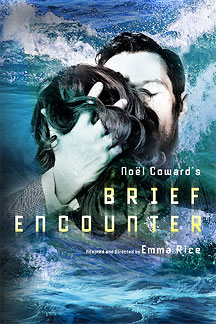 up for the greater good of their respective spouses and children. In the film Celia Johnson as the shy, inhibited housewife and Trevor Howard as the earnest doctor meet by accident in a train station, spend some time together and fall overwhelmingly in love. In the current stage version Hannah Yelland and Tristan Sturrock meet in a train station, fall overwhelmingly in love and stoicly give each other up to the heartbreaking accompaniment of Rachmaninoff’s Piano Concerto #2. But Emma Rice has other plans in mind. She has added two other sets of lovers, a spritely band and a set of musical numbers and all kinds of gimmicks such as filmed backgrounds, swinging chandeliers from which the lovers hang in midair, wildly foaming seascapes, swooning protagonists being propped up by the other couples and so forth. For comic relief the older couple Myrtle (Annette McLaughlin), who runs the tea shop at the railroad station, and Albert (Joseph Alessi), a conductor, vie with the younger waitress Beryl (Dorothy Atkinson) and the candy vendor Stanley (Gabriel Ebert) in delivering Noel Coward’s song repetoire and hijinks that lighten the somberness of the awesome love affair enfoldng in front of us. Is this an homage to the film or a mockery of it? Either way it is a funny sendoff of a long loved film set in 1938 and perhaps more moralistic than today would have it. Set and costume design by Neil Murray lighting design by Malcolm Ruppeth, sound design by Simon Baker and projection design by Jon Driscoll & Gemma Carrington complete the direction by Emma Rice in this spoof or tribute to a long ago love affair that’s as bittersweet as anyone would want.
up for the greater good of their respective spouses and children. In the film Celia Johnson as the shy, inhibited housewife and Trevor Howard as the earnest doctor meet by accident in a train station, spend some time together and fall overwhelmingly in love. In the current stage version Hannah Yelland and Tristan Sturrock meet in a train station, fall overwhelmingly in love and stoicly give each other up to the heartbreaking accompaniment of Rachmaninoff’s Piano Concerto #2. But Emma Rice has other plans in mind. She has added two other sets of lovers, a spritely band and a set of musical numbers and all kinds of gimmicks such as filmed backgrounds, swinging chandeliers from which the lovers hang in midair, wildly foaming seascapes, swooning protagonists being propped up by the other couples and so forth. For comic relief the older couple Myrtle (Annette McLaughlin), who runs the tea shop at the railroad station, and Albert (Joseph Alessi), a conductor, vie with the younger waitress Beryl (Dorothy Atkinson) and the candy vendor Stanley (Gabriel Ebert) in delivering Noel Coward’s song repetoire and hijinks that lighten the somberness of the awesome love affair enfoldng in front of us. Is this an homage to the film or a mockery of it? Either way it is a funny sendoff of a long loved film set in 1938 and perhaps more moralistic than today would have it. Set and costume design by Neil Murray lighting design by Malcolm Ruppeth, sound design by Simon Baker and projection design by Jon Driscoll & Gemma Carrington complete the direction by Emma Rice in this spoof or tribute to a long ago love affair that’s as bittersweet as anyone would want.
La Bete
La Bete is a peculiar type of beast. Written in verse rather than prose it sets out to present the conflict between vulgar, popular artistry and classical literary endeavor. David Hirson, the author appears to be making a point but what is it?
Mark Rylance is Valere, a street performer in France in 1654, who by his buffonery, constant self aggrandisement, misuse of language and constant nonsensical babble manages to alienate David Hyde Pierce as Elomire (think Moliere) the director of the royal troupe of actors in the court of the reigning Princess (Joanna Lumley). But the Princess is enamored of this raging beast and insists that Elomire add him to his troupe. Elomire protests but agrees to let Valere present one of his original plays with the aid of his troupe to aid in the decision. The play, The Parable of the Two Boys From Cadiz is so terribly inane and dreadful that the Princess's decision to chose Valere over Elomire makes asolutely no sense. Elomire, the voice of reason and integrity, is forced to leave the security of the court and explore the greater world outside.
David Hyde Pierce is excellent as Elomire but the part is underwritten and Mark Rylance is so overblown as Valere that the idea of his succeding in garnering acclaim is absurd. Joanna Lumley is a proficient Princess and Stephen Ouimette a successful Bejart, Elomire’s assistant . The set is magnificent and the incidental music is moving but Matthew Warchus, the director, has given far too much reign to Mr. Rylance who gobbles up all the air in the room.
Elling
Elling, a Norweigan novel which was made into a film, is now being presented in a stage version based on the English translation by Simon Bent. Although the novel was the sensitive story of two mentally ill individuals, this adaptation is being presented as a comedy. There are some funny moments but a comedy this is not! Elling (Denis O’Hare) is an obsessive compulsive, phobic, repressed, individual who is frightened of contact with others, hides in a closet when upset and has spent his life taking care of his now deceased mother. Kjell (Brendan Fraser) a huge giant of a man, is slow witted, slovenly, berefit of any ideal of cleanliness, a 40-year-old virgin who is constantly achieving erections he studies with little comprehension. Both men are roomates in the local mental hospital, who after a two year stay, are deemed capable of moving into a halfway house apartment with an occasional social worker (Jeremy Shamos) who urges them to “make it in society.” And after several mishaps they “sorta kinda” do. Elling makes a friend (Richard Easton) who encourages him to put his poetry on paper and Kjell falls in love with the unmarried pregnent blond (Jennifer Coolidge) who lives upstairs. They are on their way!
Scenic design is held to a bare minimum by Scott Pask while the same is done by Catherine Zuber for costumes. Production is directed by Doug Hughes. The actors all perform admirably but Hughes does not seem to be at his best in deciding the focus of the play.
Driving Miss Daisy
This is a lovely, gentle play about a relationship between a feisty white Jewish widow of 72 and a patient, kind middle aged black man who becomes her 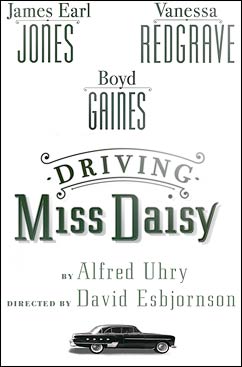 chauffeur at the insistence of her son who does not want to hear about any more accidents caused by his mother’s erratic driving. It takes places in Atlanta during the 1950s and 1960s at the height of the Civil Rights Movement which adds more pungency to the very delicate, dependent relationship developed between the two. Initally Daisy Werthan (Vanessa Redgrave) is an opinated, crusty woman who values her independance and refuses to have anyone drive her anywhere. Hoke Coleburn (James Earl Jones) waits her out, patiently accepts her bossiness and gradually developes a tender, caring friendship with her so that in 1972 he becomes the one who visits her in the nursing home, feeding her dinner to her in gentle steps. There are many comic moments getting to this point as well as confrontations and genuine illuminations. Vanessa Redgrave, is of course, superb as is James Earl Jones and Boyd Gaines in their respective roles. John Lee Beatty designed the bare bones sets, Jane Greenwood the appropriate costumes. The production is directed by David Esbjornson who pays soft focus homage to this lovely play by Alfred Uhry.
chauffeur at the insistence of her son who does not want to hear about any more accidents caused by his mother’s erratic driving. It takes places in Atlanta during the 1950s and 1960s at the height of the Civil Rights Movement which adds more pungency to the very delicate, dependent relationship developed between the two. Initally Daisy Werthan (Vanessa Redgrave) is an opinated, crusty woman who values her independance and refuses to have anyone drive her anywhere. Hoke Coleburn (James Earl Jones) waits her out, patiently accepts her bossiness and gradually developes a tender, caring friendship with her so that in 1972 he becomes the one who visits her in the nursing home, feeding her dinner to her in gentle steps. There are many comic moments getting to this point as well as confrontations and genuine illuminations. Vanessa Redgrave, is of course, superb as is James Earl Jones and Boyd Gaines in their respective roles. John Lee Beatty designed the bare bones sets, Jane Greenwood the appropriate costumes. The production is directed by David Esbjornson who pays soft focus homage to this lovely play by Alfred Uhry.
Colin Quinn / Long Story Short
Colin Quinn, a seasoned veteran of TV’s Saturday Night Live, is known for his wry humor, tough guy attitude and ability to sustain a monologue. Here he does so for 75 minutes as his History of the World subtitle explains. Beginning with primitive man, proceeding to the Greeks and the Romans, adding the Vatican, throwing in Islam, England, Europe, Africa, Mexico, South America and India, ending up in America. Quinn attempts to explain every aspect of those so-called doomed societies and does so with crackling humor. In the background on stage is a huge screen on which is projected all the geography, art and culture of the various societies he is decimating—making everything crystal clear. For example its easy to see why the delegates to the economic summit preceding the world financial meltdown declared all was well as they were reporting in the sunny climate in the Swiss Alps where all was peaceful.
The show raced by at breakneck speed, the audience laughed uproariously and Quinn was quite delightful. It was directed by another TV star, Jerry Seinfeld, who is described in the Playbill as a comedian who lives in NY with his wife and children. Subtlety is thy name.
Women On The Verge Of A Nervous Breakdown
When Pedro Almodovar wrote this script in 1987 Spain had shucked off years of fascism and become a democracy thus giving reign to the excess of hedonism which often follows freedom. This translation from film to stage retains the 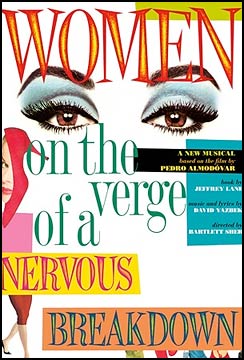 maniacal character of the endeavor but unfortunately becomes a hodge podge of excess. Too much is happening, chaos ensues. The magnificent cast of experienced actors are all over the place, the action is frantic, the scenes shift rapidly with some fantastic stunts and beautiful background films of Spain but the end result is exhaustion for the audience.
maniacal character of the endeavor but unfortunately becomes a hodge podge of excess. Too much is happening, chaos ensues. The magnificent cast of experienced actors are all over the place, the action is frantic, the scenes shift rapidly with some fantastic stunts and beautiful background films of Spain but the end result is exhaustion for the audience.
In brief, if one can be brief in all this hullabalu, Pepa (Sherie Rene Scott) a Spanish actress is informed by her lover, Ivan (Brian Stokes Mitchell) on the telephone machine, that he is leaving her. He then becomes incommunicado and she spends the a rest of the play looking for him to demand an explanation. At the same time Ivan’s ex-wife Lucia (Patti LuPone) has been released from a mental hospital and is suing him for her lost years. She too is looking for him. Ivan’s son Carlos (Justin Guarini) is afraid to tell his mother Lucia that he wants to leave her to marry his girl friend Marisa (Nikka Graff Lanzarone) he is also looking for his father. Pepa’s best girl friend the dim-witted Candela (Laura Benanti) is frantically phoning Pepa for help as she has fallen in love with a man who turns out to be a terrorist. She is looking for Pepa. A few other characters are roaming in and out of the action including Danny Burstein, a cab driver, who magically appears whenever Pepa needs a ride. And then there is Lucia’s lawyer Paulina (de’Adre Aziza) who somehow manages to find Ivan only to become entangled in this pot pourie. David Yazbek has written some beautiful songs Including “Lie To Me” (Pepa) “Model Behavior” (Candela) and “Impossible” (Lucia), Michael Yeargan has designed some delicious sets and Sven Ortel has supplied the film projections while Bartlett Sher has directed at a frantic pace. There are good moments but judicious editing would have been a blessing.
The Scottsboro Boys
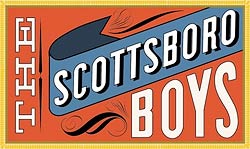 The idea of presenting an American Tragedy in the form of a minstrel show can be considered inspiring or insipid depending on one’s point of view. In this case it suceeds admirably in revealing the hypocrisy and viciousness of the segregated Jim Crow South of the 1930s in an entertaining yet truly heartbreaking and moving fashion. John Kander, Fred Ebb (music & lyrics) and David Thompson (book) along with Susan Stroman as director and choreographer have somehow caught the beat of the legal circus that destroyed nine lives but was influential in bringing about change in America that was sorely needed. For those who do not know, nine black boys were charged with raping two white women in 1931 in an Alabama courthouse. They were innocent but despite that were declared guilty and sentenced to death throughout all the trials that were subsequently repeated for various reasons. The show tells the story in minstrel form with John Cullum as the white Interlocuter, Colman Domingo as Mr. Bones and Forrest McClendon as Mr.Tambo. Nine excellent performers play the Scottsboro boys who expose their trials and tribulations in various song and dance movements. All are superb but Joshua Henry with his fantastic physique and vocal range shines, particularly in a moving ballad called “Go Back Home.” The ending is tragic for all, even those who were paroled, but the hope for the future is personified in the character of “The Lady” (Sharon Washington) who turns out to be Rosa Parks, the spark that ignited The Civil Rights Movement.
The idea of presenting an American Tragedy in the form of a minstrel show can be considered inspiring or insipid depending on one’s point of view. In this case it suceeds admirably in revealing the hypocrisy and viciousness of the segregated Jim Crow South of the 1930s in an entertaining yet truly heartbreaking and moving fashion. John Kander, Fred Ebb (music & lyrics) and David Thompson (book) along with Susan Stroman as director and choreographer have somehow caught the beat of the legal circus that destroyed nine lives but was influential in bringing about change in America that was sorely needed. For those who do not know, nine black boys were charged with raping two white women in 1931 in an Alabama courthouse. They were innocent but despite that were declared guilty and sentenced to death throughout all the trials that were subsequently repeated for various reasons. The show tells the story in minstrel form with John Cullum as the white Interlocuter, Colman Domingo as Mr. Bones and Forrest McClendon as Mr.Tambo. Nine excellent performers play the Scottsboro boys who expose their trials and tribulations in various song and dance movements. All are superb but Joshua Henry with his fantastic physique and vocal range shines, particularly in a moving ballad called “Go Back Home.” The ending is tragic for all, even those who were paroled, but the hope for the future is personified in the character of “The Lady” (Sharon Washington) who turns out to be Rosa Parks, the spark that ignited The Civil Rights Movement.
Scenic Design by Beowulf Boritt is minimal but effective while lighting design by Ken Billington gets the mood perfectly. Susan Stroman is at her very best and overall the show is a unique success.
 |
|
 |

